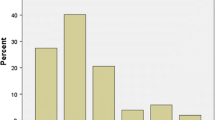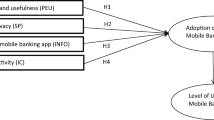Abstract
The fast advancement of mobile technologies and devices has increased the importance of mobile banking (m-banking) for financial institutions. Even though numerous studies have investigated the drivers of m-banking adoption, up to now there is no study that has critically reviewed the findings of previous efforts and evaluated the results in this field for researchers as well as practitioners. As a consequence, this article explores the most commonly used drivers to examine the adoption of m-banking through a comprehensive and up-to-date literature review of articles published between 2008 and 2011. With it, the results not only indicate that the Technology Acceptance Model (TAM) was mainly adapted by most m-banking studies but also reveal that the most common drivers of adoption can be categorized into four major dimensions, i.e. perceived usefulness, perceived risk, perceived compatibility and perceived cost. This article gives an introduction to the heightened relevance of m-banking, provides researchers with an overview of frequently harnessed drivers of m-banking adoption as well as future research opportunities and equips practitioners with an understanding for m-banking customers and corresponding managerial decisions.

Similar content being viewed by others
References
Ajzen, I. (1991). The theory of planned behavior. Organizational Behavior and Human Decision Processes, 50(2), 179–211.
Anckar, B., & D’Incau, D. (2002). Value creation in mobile commerce: findings from a consumer survey. The Journal of Information Technology Theory and Application, 4(1), 43–64.
Anderson, J. (2010). M-banking in developing markets: competitive and regulatory implications. Info, 12(1), 18–25.
APA. (2009). Publication manual of the American Psychological Association (6th ed.). Washington, DC: APA.
Bhimani, A. (1996). Securing the commercial internet. Communications of the ACM, 39(6), 29–35.
Bouwman, H., Carlsson, C., Molina-Castillo, F. J., & Walden, P. (2007). Barriers and drivers in adopting actual and future mobile services in Finland. Telematics, 24(2), 145–160.
Brown, I., Cajee, Z., Davies, D., & Stroebel, S. (2003). Cell phone banking: predictors of adoption in South Africa – an exploratory study. International Journal of Information Management, 23(5), 381–394.
Buse, S. (2002). Der mobile Erfolg – Ergebnisse einer empirischen Untersuchung in ausgewählten Branchen. In F. Keuper (Ed.), Electronic business und mobile business. Ansätze, Konzepte und Geschäftsmodelle. Wiesbaden: Gabler.
Capgemini & RBS (2011). World Payments Report 2011. Retrieved 16 September, 2011, from http://www.capgemini.com/insights-and-resources/by-publication/world-payments-report-2011/.
Chen, L. (2008). A model of consumer acceptance of mobile payment. International Journal of Mobile Communications, 6(1), 32–52.
Chung, N., & Kwon, S. J. (2009). The effects of customers’ mobile experience and technical support on the intention to use mobile banking. Cyber Psychology and Behavior, 12(5), 539–543.
Cisco VNI (2011). Cisco Visual Networking Index: Global Mobile Data Traffic Forecast Update, 2010–2015. Retrieved 13September, 2011, from http://www.cisco.com/en/US/solutions/collateral/ns341/ns525/ns537/ns705/ns827/white_paper_c11-520862.pdf.
Clark, B., & Penrose, E. (2009). Monetize Chapter Three - Banks, service and technology. Retrieved 22 August, 2011, from http://www.monitisegroup.com/uploads/assets/docs/money_on_the_move_chapter_three.pdf.
Clarke, I., III. (2008). Emerging value propositions for m-commerce. Journal of Business Strategies, 18(2), 133–148.
Bain & Company (2009). Mobile Internet for Growth: Project Report. World Economic Forum Annual Meeting 2009. Davos, Switzerland, January 2009. Retrieved April 30, 2012, from http://www.bain.com/bainweb/PDFs/cms/Public/WEF_2009_Mobile_Internet.pdf
comScore (2011b). Press Release May 2011. Retrieved 1 August, 2011, from http://www.comscore.com/Press_Events/Press_Releases/2011/5/Europe_Sees_40_Percent_Growth_in_mobile_banking_Through_Smartphones.
Cruz, P., Filgueiras Neto, L. B., Muñoz-Gallego, P., & Laukkanen, T. (2010). Mobile banking rollout in emerging markets: evidence from Brazil. International Journal of Bank Marketing, 28(5), 342–371.
Dahlberg, T., Mallat, N., Ondrus, J., & Zmijewska, A. (2008). Past, present and future of mobile payments research: a literature review. Electronic Commerce Research and Applications, 7, 165–181.
Datamonitor. (2009). Mobile banking: over-hyped gimmick or credible 21st century banking channel? New York: Datamonitor.
Davis, F. D. (1989). Perceived usefulness, perceived ease of use, and user acceptance of information technology. MIS Quarterly, 13(3), 319–340.
Davis, F. D., Bagozzi, R. P., & Warshaw, P. R. (1989). User acceptance of computer technology: a comparison of two theoretical models. Management Science, 35, 982–1003.
Deutsche Bank Research (2007). Mobile banking is ringing again. Will customers Answer?. Retrieved 29 August, 2011, from http://www.dbresearch.com/PROD/DBR_INTERNET_EN.
Fettke, P. (2006). State-of-the-Art des State-of-the-Art: Eine Untersuchung der Forschungsmethode “Review” innerhalb der Wirtschaftsinformatik. Wirtschaftsinformatik, 48(4), 257–266.
Gartner Research (2011a). Forecast: Mobile Communications Devices by Open Operating System, Worldwide, 2008–2015. Retrieved 12 February, 2012, from http://www.gartner.com/it/page.jsp?id=1622614.
Gartner Research (2011b). Gartner Says Worldwide Mobile Payment Users to Reach 141 Million in 2011. Retrieved 3 March, 2012, from http://www.gartner.com/it/page.jsp?id=1749114.
Geffen, D., & Straub, D. W. (2000). The relative importance of perceived ease of use in IS adoption: a study of E-Commerce adoption. Journal of the Association for Information Systems, 1(1), 1–20.
Georgi, F., & Pinkl, J. (2005). Mobile banking in Deutschland. Die Bank, 3(1), 57–61.
Gu, J. C., Lee, S. C., & Suh, Y. H. (2009). Determinants of behavioral intention to mobile banking. Expert Systems with Applications, 36(7), 11605–11616.
Herzberg, A. (2003). Payments and banking with mobile personal devices. Communications of the ACM, 46(5), 53–58.
Hofstede, G. (2001). Culture’s consequences: comparing values, behaviors, institutions and organizations across nations, 2. ed. Thousand Oaks: Sage Publications.
IDC (2011). Worldwide Smartphone Market. Retrieved 13 September, 2011, from http://www.idc.com/getdoc.jsp?containerId=prUS22871611.
iSuppli (2011). Media Tablet Forecast. Retrieved 14 September, 2011, fromhttp://www.isuppli.com/Display-Materials-and-Systems/News/Pages/Media-Tablet-Forecast-Increased-as-Apple’s-Dominance-Grows.aspx.
ITU (2011). Key ICT indicators for developed and developing countries and the world (totals and penetration rates). Retrieved 30 April, 2012, http://www.itu.int/ITU-D/ict/statistics/at_glance/KeyTelecom.html.
Kanniainen, L. (2010). Alternatives for banks to offer secure mobile payments. International Journal of Bank Marketing, 28(5), 433–444.
Kemper, G. G., & Wolf, E. (2002). Iterative process models for mobile application systems: a framework. ICIS 2002 Proceedings, Paper 37, 401–413.
Kim, G., Shin, B., & Le, H. G. (2009). Understanding dynamics between initial trust and usage intentions of mobile banking. Information Systems Journal, 19(3), 283–311.
Kim, C., Mirusmonov, M., & Lee, I. (2010). An empirical examination of factors influencing the intention to use mobile payment. Computers in Human Behavior, 26, 310–322.
Koenig-Lewis, N., Palmer, A., & Moll, A. (2010). Predicting young consumers’ take up of mobile banking services. International Journal of Bank Marketing, 28(5), 410–432.
KPMG (2011). Monetizing Mobile - How banks are preserving their place in the payment value chain. Retrieved 3 August, 2011, from http://www.kpmg.com/GI/en/IssuesAndInsights/ArticlesPub.
Kuisma, T., Laukkanen, T., & Hiltunen, M. (2007). Mapping the reasons for resistance to Internet banking: a means -end approach. International Journal of Information Management, 27(2), 75–85.
Kwiatkowski, A. (2010). Can mobile banking fulfil its potential?. Retrieved 13 September, 2011, from www.telecoms.com/14746/can-mobile-banking-fulfil-its-potential.
Laukkanen, T. (2007a). Internet vs. mobile banking: comparing customer value perceptions. Business Process Management Journal, 13(6), 788–797.
Laukkanen, T. (2007b). Measuring mobile banking customers’ channel attribute preferences in service consumption. International Journal of Mobile Communications, 5(2), 123–138.
Laukkanen, T., & Kiviniemi, V. (2010). The role of information in mobile banking resistance. International Journal of Bank Marketing, 28(5), 372–388.
Laukkanen, T., & Lauronen, J. (2005). Consumer value creation in mobile banking services. International Journal of Mobile Communications, 3(4), 325–338.
Laukkanen, T., Sinkonnen, S., Kivijärvi, M., & Laukkanen, P. (2008). Innovation resistance among mature consumers. Journal of Consumer Marketing, 24(7), 419–427.
Lawrence, E., Pernici, B., & Krogstie, J. (2004). Mobile Information Systems. IFIP TC 8 Working Conference on Mobile Information Systems (MOBIS), 15–17 September 2004, 177–180.
Lee, J., & Allaway, A. (2008). Effects of personal control on adoption of self-service technology innovations. Journal of Services Marketing, 16(6), 553–572.
Lee, K. C., & Chung, N. (2009). Understanding factors affecting trust in and satisfaction with mobile banking in Korea: a modified DeLone and McLean’s model perspective. Interacting with Computers, 21(5), 385–392.
Lee, E.-J., Lee, J., & Eastwood, D. (2003). A two-step estimation of consumer adoption of technology-based service innovations. The Journal of Consumers Affairs, 37(2), 256–282.
Lee, Y.-K., Park, J.-H., & Chung, N. (2009). An Exploratory Study on Factors Affecting Usage Intention toward mobile banking: A Unified Perspective Using Structural Equation Modeling. Society for Marketing Advances Proceedings, 347–369.
Lin, H. F. (2010). An empirical investigation of mobile banking adoption: the effect of innovation attributes and knowledge-based trust. International Journal of Information Management, 3(3), 252–260.
Luarn, P., & Lin, H. (2008). Toward an understanding of the behavioural intention to use mobile banking. Computers in Human Behavior, 21(6), 873–891.
Mallat, N. (2008). Exploring consumer adoption of mobile payments – a qualitative study. The Journal of Strategic Information Systems, 16, 413–432.
Mallon, D. (2010). The Business Case for Mobile Banking. Retrieved 30 April, 2012, from http://www.sybase.com/detail?id=1082639.
Morgan Stanley Research (2010). Mobile Internet Trends. Retrieved 1 August, 2011, from http://www.morganstanley.com/institutional/techresearch/pdfs/Internet_Trends_041210.pdf.
Paisner, J., Castonguay, A., & Collins, C. (2009). Mobile Banking Creates a Bright Spot Within the Struggling Financial Services Industry. Retrieved 24 August, 2011, from http://us.blackberry.com/business/industry/financial/mobile_banking_Whitepaper.pdf.
Püschel, J., Mazzon, J. A., & Hernandez, J. M. C. (2010). Mobile banking: proposition of an integrated adoption intention framework. International Journal of Bank Marketing, 28(5), 389–409.
Rainer, K., & Miller, M. (2005). Examining differences across journal rankings. Communications of the ACM, 48(2), 91–94.
Ram, S. (1987). A model of innovation resistance. Advances in Consumer Research, 14(1), 208–212.
Riquelme, H. E., & Rios, R. E. (2010). The moderating effect of gender in the adoption of mobile banking. International Journal of Bank Marketing, 28(5), 328–341.
Rogers, E. M. (1995). Diffusion of innovations (4th ed.). New York: The Free Press.
Schierz, P. G., Schilke, O., & Wirtz, B. W. (2009). Understanding consumer acceptance of mobile payment services: an empirical analysis. Electronic Commerce Research and Applications, 9, 209–216.
Shin, D.-H. (2009). Towards an understanding of the consumer acceptance of mobile wallet. Computers in Human Behavior, 25(6), 1343–1354.
Suoranta, M., & Mattila, M. (2004). Mobile banking and consumer behavior: new insights into the diffusion pattern. Journal of Financial Services Marketing, 8(4), 354–366.
Swilley, E. (2010). Technology rejection: the case of the wallet phone. Journal of Consumer Marketing, 27(4), 304–312.
Teo, T., Lee, C. B., Chai, C. S., & Wong, S. L. (2009). Assessing the intention to use technology among pre-service teachers in Singapore and Malaysia: a multigroup invariance analysis of the Technology Acceptance Model (TAM). Computers in Education, 53(2), 1000–1009.
Tiwari, R., & Buse, S. (2007). The mobile commerce prospects: a strategic analysis of opportunities in the banking sector. Hamburg: Hamburg University Press.
UK Department for International Development (2010). Summit to help “unbanked” people in developing world. Retrieved 3 August, 2011, from http://www.dfid.gov.uk/Media-Room/News-Stories/2010/Summit-looks-to-help-unbanked-in-developing-world/.
Urbach, N., Smolnik, S., & Riempp, G. (2009). The state of research on information systems success - a review of existing multidimensional approaches. Business & Information Systems Engineering (BISE) - The International Journal of Wirtschaftsinformatik, 1(4), 315–325.
Varshney, U. (2004). Group-oriented mobile services: requirements and solutions. Information Systems and e-Business Management, 2(4), 325–335.
Venkatesh, V., & Davis, F. D. (2000). A theoretical extension of the technology acceptance model: four longitudinal field studies. Management Science, 46(2), 186–204.
Venkatesh, V., Morris, M. G., Davis, G. B., & Davis, F. D. (2003). User acceptance of information technology: toward a unified view. MIS Quarterly, 27(3), 425–478.
VeriSign, M-Com, & Fiserv (2009). New Research Reveals Untapped Market for Mobile Banking Among Offline Consumers. Retrieved 9 August, 2011, from http://www.mcom.co.nz/assets/sm/284/12/M-Com,FiservandVeriSign-OfflineConsumersResearchPaperOct2009.pdf.
Webster, J., & Watson, R. T. (2002). Analyzing the past to prepare for the future: writing a literature review. MIS Quarterly, 26(2), xiii–xxiii.
Wessels, L., & Drennan, J. (2010). An investigation of consumer acceptance of M-banking. International Journal of Bank Marketing, 28(7), 547–568.
Zhou, T. (2010). The impact of privacy concern on user adoption of location-based services. Industrial Management & Data Systems, 111(2), 212–226.
Author information
Authors and Affiliations
Corresponding author
Additional information
Responsible Editor: Roger W. H. Bons
Rights and permissions
About this article
Cite this article
Ha, KH., Canedoli, A., Baur, A.W. et al. Mobile banking — insights on its increasing relevance and most common drivers of adoption. Electron Markets 22, 217–227 (2012). https://doi.org/10.1007/s12525-012-0107-1
Received:
Accepted:
Published:
Issue Date:
DOI: https://doi.org/10.1007/s12525-012-0107-1




